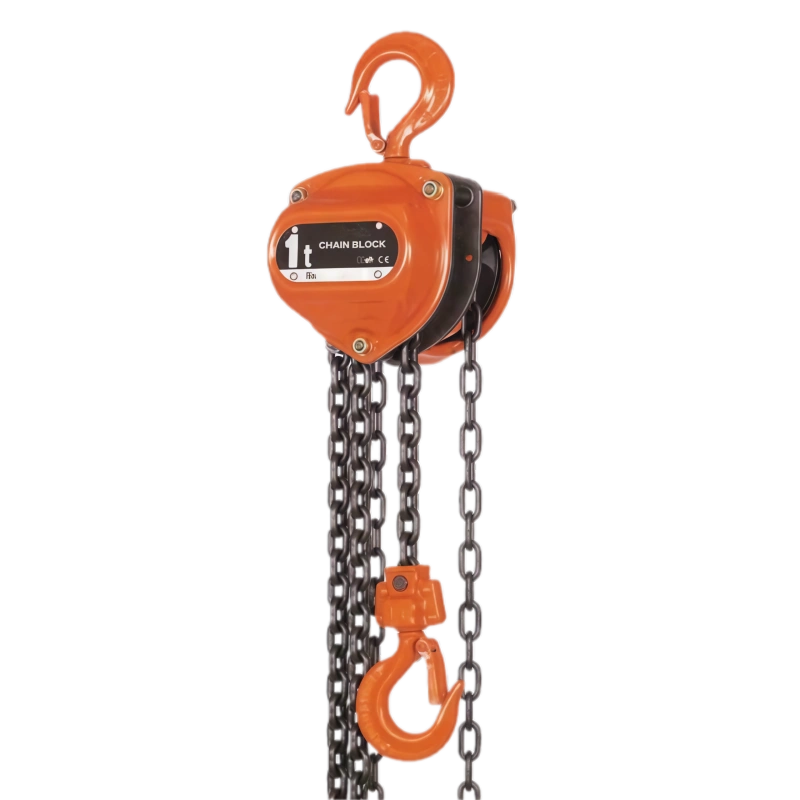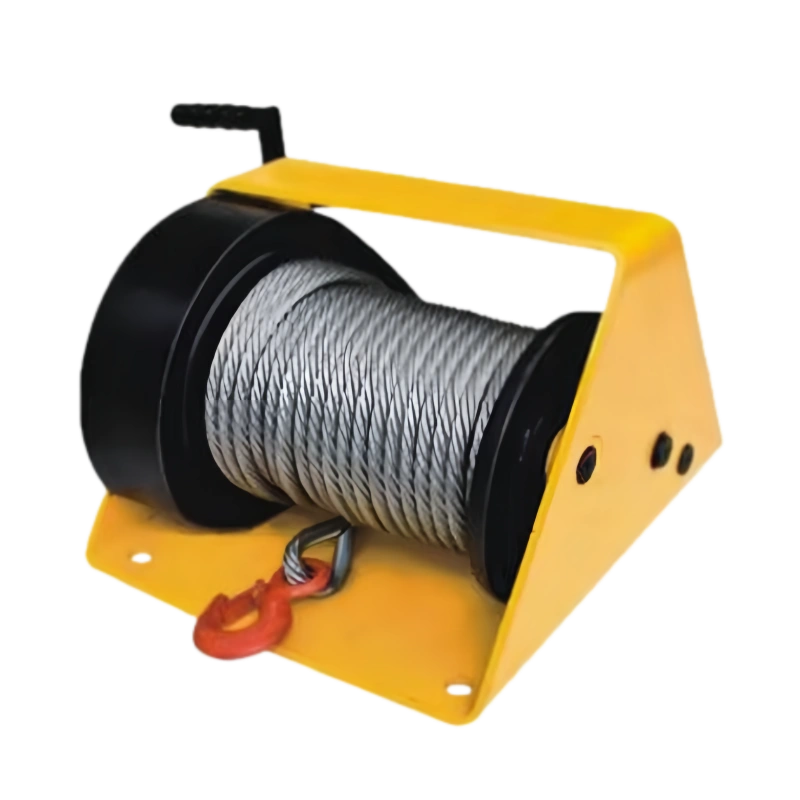HAND CHAIN HOISTS SPECIFICATIONS
| Model | K1/12 | K1/1 | K1/1/2 | K1/2 | K1/3 | K1/5 | K1/10 |
| Capacity (t) | 0.5 | 1 | 1.5 | 2 | 3 | 5 | 10 |
| Standard lift (m) | 2.5 | 2.5 | 2.5 | 3 | 3 | 3 | 3.5 |
| Test load (t) | 0.75 | 1.5 | 2.25 | 3 | 4.5 | 7.5 | 15 |
| Min.distance between hooks (mm) | 285 | 315 | 340 | 380 | 475 | 600 | 700 |
| Chainpull to lift full load (n) | 25 | 33 | 34 | 34 | 35 | 39 | 41 |
| No. of load chain fall lines | 1 | 1 | 1 | 1 | 2 | 2 | 4 |
| Diameter of load chain (mm) | 6.3 | 6.3 | 7.1 | 8 | 7.1 | 9 | 9 |
| Net weight (kg) | 8.4 | 11 | 13.5 | 21 | 22 | 40 | 77 |
| Gross Weight (kg) | 9.4 | 12 | 14.5 | 22 | 23 | 41.5 | 85 |
| Packing measurement L×W×H (cm) | 26×16×20 | 26×16×20 | 27×18×24 | 27×18×24 | 28×19×26 | 39×22×30 | 48×46×26 |
FEATURES OF HAND OPERATED CHAIN HOIST
Double Pawl Braking System: Enhances safety by preventing accidental load release.
G80 Alloy Steel Load Chain: Provides high strength and long-term durability, even in the toughest conditions.
Compact & Portable: Lightweight design allows for easy handling in confined spaces.
Heavy-Duty Capacity: Available in capacities from 0.5t to 50t, accommodating a variety of lifting needs.
Sealed Bearings: Increases mechanical efficiency and reduces maintenance time.
High-Quality Materials: Powder-coated for protection against dust and moisture.
HAND OPERATED CHAIN HOISTS INSTRUCTIONS & CAUTIONS
Inspect Before Every Use
Before each use, always give your hand chain hoist a thorough inspection. Check for any signs of wear, damage, or malfunction, particularly on the chain, hooks, and lifting mechanism. If anything seems off, don’t use the hoist until it’s repaired. Regular inspections are crucial to ensure safe operation and avoid costly repairs.
Never Exceed the Load Capacity
Always be mindful of the hoist’s rated load limit. Lifting anything beyond its capacity can lead to failure, which could damage the hoist or cause an accident. Double-check the load before you start lifting to ensure it’s within the hoist’s limit. If you’re unsure, use a scale to measure or consult with a professional.
Operate in a Safe, Clear Area
Make sure you’re using the hoist in a clean, stable, and level area. The environment should be free from any obstacles that could make the load unstable or cause accidents. Keeping the area clear and organized will reduce the risk of distractions and help maintain a safe working space.
Regular Maintenance is Essential
Handle the hoist carefully to avoid twisting or kinking the chain, as this can affect its performance. Routine maintenance is a must. Clean the hoist regularly and lubricate the chain according to the manufacturer’s guidelines to ensure smooth operation and extend its lifespan.
OUR ADVANTAGES
Custom Solutions Designed for You
Every business has unique needs. That’s why we specialize in custom-engineered solutions that fit your exact requirements. Whether it's a specific load capacity or a tailored feature, we work with you to deliver equipment designed for your operations. This flexibility and personalization ensure you're getting the best solution to meet your challenges.
One-Stop Sourcing for Convenience
We make sourcing easy for you. By offering a complete range of lifting equipment under one roof, Powerful Machinery streamlines your procurement process. You won’t have to juggle multiple suppliers, saving you time and effort. This one-stop solution allows you to focus on your core business while we handle the sourcing and logistics.
Reliable Logistics and Timely Delivery
We understand that on-time delivery is crucial to your business. Powerful Machinery ensures quick and efficient logistics, with reliable transportation partners to get your orders to you on time, every time. Our strong logistics network helps us keep your operations on track, minimizing delays and maximizing productivity.
Unmatched After-Sales Support
At Powerful Machinery, we believe in building long-term relationships with our customers. Our dedicated after-sales support team ensures your equipment runs smoothly and efficiently, offering guidance on installation, maintenance, and troubleshooting. Unlike other manufacturers, our customer support continues long after the sale, so you can trust us to keep your operations running smoothly.
FAQ
What are the advantages of using a hand chain hoist?
Cost-effective: Hand chain hoists are affordable, offering excellent value for businesses of all sizes.
No electricity required: These hoists are perfect for locations without power sources, ensuring versatile use.
Durable and low-maintenance: With proper care, they provide long-term reliability and require minimal maintenance.
Portable and easy to use: Their lightweight design makes them ideal for both small and large-scale lifting tasks.
Lever Hoist vs Hand Chain Hoist: What’s the Difference?
Lever hoist: Uses a ratchet lever, providing precise control and faster operation for heavy-duty tasks.
Hand chain hoist: Operates by pulling a chain to engage gears, offering a simpler and more cost-effective solution for lighter loads.
Use case: Lever hoists are suited for heavy, precise lifts, while hand chain hoists are ideal for general lifting tasks.
How does a manual chain hoist work?
A manual chain hoist works by pulling a hand-operated chain, which engages a gear system that lifts the load. As you pull the chain, it rotates the gears, causing the load hook to rise. The simple mechanical design ensures reliability, and since no power is needed, it’s a convenient solution for lifting in almost any environment, from construction sites to warehouses.
How do I use a manual chain hoist?
Secure the hoist: Attach the hoist to a stable support structure to ensure safety during operation.
Attach the load: Properly balance the load on the hook before lifting.
Lift the load: Pull the hand chain steadily and evenly, avoiding jerking or overloading the hoist for smooth operation.
Lower the load: Release the chain slowly and carefully to lower the load.
Follow safety guidelines: Always adhere to safety protocols to prevent accidents and equipment damage.
Manual Chain Hoist Inspection Requirements
Chain inspection: Check the chain for wear, fraying, or any visible damage.
Hook inspection: Ensure the hooks are not bent, cracked, and that the safety latch works properly.
Brake test: Verify that the brake system holds the load securely.
Regular checks: Perform a thorough inspection before every use, and a detailed check every 6 months. More frequent checks are recommended for high-use hoists.
How do I repair a manual chain hoist?
Identify the issue: Start by determining what’s causing the malfunction (worn chain, faulty brake, damaged hook, etc.).
Disassemble as needed: If required, disassemble the hoist to access the internal mechanisms for inspection.
Replace damaged parts: Replace worn or damaged parts, such as the chain or brake.
Seek professional help: For safety, consult a professional to ensure the hoist is repaired properly and operates safely.
How long will a hand chain hoist last?
With proper maintenance, a well-made manual chain hoist can last many years. On average, a quality hoist can last between 5 to 10 years, depending on how often it’s used and how well it’s maintained. Regular inspections, proper storage, and keeping the chain lubricated will significantly extend its lifespan, ensuring you get the most out of your investment.
How do I prevent wear and tear on a hand chain hoist?
Handle with care: Avoid overloading the hoist or subjecting it to excessive strain to prevent unnecessary wear.
Regular inspection: Check the hoist and chain for signs of damage or wear after each use.
Lubricate the chain: Keep the chain lubricated to reduce friction and prevent premature wear.
Keep it clean: Clean the hoist regularly and remove any debris to ensure smooth operation.
Proper storage: Store the hoist in a dry, clean area to prevent rust and corrosion.
Follow maintenance guidelines: Adhere to the manufacturer’s maintenance recommendations and perform regular checks to catch potential issues early.
What are the common problems with hand chain hoists?
Chain slippage: Caused by improper maintenance, wear, or insufficient lubrication.
Jamming: Can occur if the chain is dirty, damaged, or improperly stored.
Failure to lift the load: Often due to overloading, worn-out components, or lack of proper inspection.
How to prevent these issues:
Regular cleaning and lubrication: Keep the hoist clean and lubricated to ensure smooth operation.
Frequent inspections: Check for signs of wear or damage, especially on the chain and hooks.
Avoid overloading: Always use the hoist within its rated load capacity to maintain safety and prevent damage.




